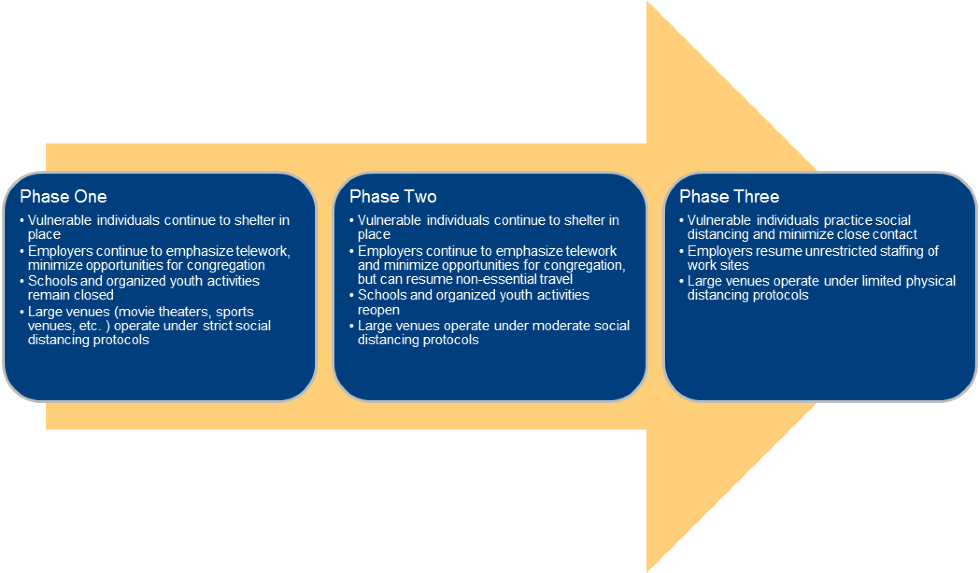BCLPemerging.com
Back to Work: Practical Considerations from the U.S. Federal Reopening Guidelines
Apr 24, 2020On April 16, the White House and the CDC released guidelines for a phased reopening of the U.S. economy. Most states and localities have been under “stay at home” or “shelter in place” orders since mid-March, and many jurisdictions are now considering how and when to lift these restrictions. The federal guidelines provide a broad blueprint for what a phased reopening could look like.
The guidelines anticipate that states and regions will move at different speeds, and that the recommendations will be tailored to each state or region’s individual circumstances. Several states, including New York, California, Ohio, Georgia, and Texas, have already announced their own plans for reopening.
Phased Reopening
The federal guidelines suggest that states implement the following phased approach to reopening:
The guidelines note that in all phases of reopening, individuals should continue to practice good hygiene as recommended by the CDC (including hand washing and covering sneezes and coughs) and should stay home if they feel sick. The guidelines also recommend that employers follow applicable recommendations regarding social distancing, protective equipment, temperature checks, testing and contact tracing, and sanitation throughout all phases of reopening.
Gating Criteria
In order to help states determine when each of the phases should be implemented, the guidelines also include three categories of “gating criteria,” which each state or region should satisfy before starting the reopening process and before moving to each subsequent phase:
- Symptoms: states should have a downward trajectory of influenza-like illnesses AND a downward trajectory of COVID-like cases reported within a 14-day period
- Cases: states should have a downward trajectory of documented cases within a 14-day period OR a downward trajectory of positive tests as a percent of total tests within a 14-day period (flat or increasing volume of tests)
- Hospitals: should be able to treat all patients without crisis care AND have a robust testing program in place for at-risk healthcare workers, including emerging antibody testing
Next Steps for Businesses
There is no doubt that states will ease stay at home orders and allow some businesses to resume in person operations over the coming months. What remains to be seen is what businesses will be allowed to go back to work, when, and what restrictions will be imposed to ensure worker and general population safety. The federal guidelines provide a structure that is likely to be adopted by certain states, and tracks some or all of the proposals that have already been issued by the states that have announced some form of return to work plan or order.
In light of the federal guidance, and the state announcements, businesses that are currently prohibited from in person operations should consider taking the following steps to prepare for reopening:
1. Develop plans to comply with the anticipated social distancing requirements
a. 6 foot distance between employee work stations
b. Marked spacing in areas where lines form
c. Protections for employees who have direct customer interactions
d. Availability of wash stations, hand sanitizers, face masks, and other appropriate PPE
2. Confirm that cleaning staff or vendors are prepared to comply with CDC, OSHA, state, and local cleaning requirements
3. Develop protocols for identifying and addressing COVID illness in the workplace
4. Develop policies regarding leave for suspected COVID illness, and employee messaging
5. Prepare your supply chain for your reopen by providing your suppliers with advance notice of your anticipated reopen date, and getting information on lead times for necessary products
6. Notify your customers that you hope to be resuming in-person operations, recognizing that until the return to work orders are issued, it is unclear what those resumed operations will entail, and when they will be approved
A more detailed overview of the steps businesses can take to prepare for reopening can be found here: https://www.bclplaw.com/en-US/insights/covid-19-us-preparing-a-re-opening-plan-five-steps-to-take-right-now.html
BCLP is actively tracking new developments regarding COVID-19 shutdown orders, and associated guidance, so please contact the COVID-19 Shutdown Team if you have specific jurisdictional questions or if it would be helpful to have a portfolio audit so that your team can more effectively manage these changes across jurisdictions as they occur.




